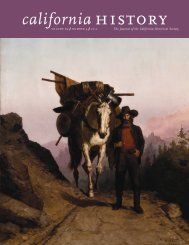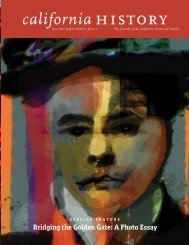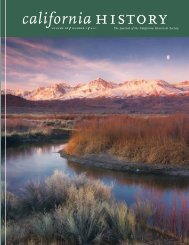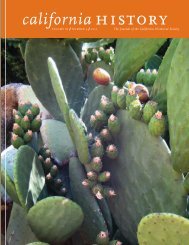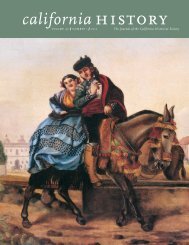california history - California Historical Society
california history - California Historical Society
california history - California Historical Society
Create successful ePaper yourself
Turn your PDF publications into a flip-book with our unique Google optimized e-Paper software.
“Quickly turned!” James crowed to his father. “Aman with good capital, sagacity and caution intaking only safe titles must soon make money intown. . . ,” he advised T.C., while admitting that,without greater population growth and the constructionof waterworks and irrigation systems,southern <strong>California</strong>’s historic Mexican ranchos,which now could be inexpensively acquired,wouldn’t be worth the trouble of “cutting up.” 31Until such day as their envisioned ranch could beprofitably subdivided into home lots, the brothersbelieved that the family could earn most of itskeep by raising sheep on the still-to-be-purchasedproperty. For a while, T.C. also had entertainednotions of starting a private bank in Santa Barbara.Mark Sibley made discreet inquiries aroundtown and reported back that a “man with $50,000to $100,000 could do very well out here . . . makingloans on real estate at 1.5 percent” to newcomerswho believed in the state’s unlimited future.The elder Severance did not have, or know how toraise, such a stupendous sum. 32James Seymour had been the first of the BostonSeverances to go west—for reasons of health.“Seymour” (the pet name used by the family)had attended Bronson Alcott’s private schoolin Concord, Massachusetts, where he struck upfriendships with May Alcott and her sister Louisa.Seymour was not intellectually inclined himself,and, upon completing his studies at twenty-one,informed his father that he wanted to find outdoorwork, supportive of “healthfulness.” Hismother’s insistence on a progressive educationfor her children, including exposure to the teachingsof physician Dioclesian Lewis, a pioneeringadvocate of the benefits of physical educationfor girls and women as well as young men, mayhave influenced Seymour’s unexpected careerpreferences. 33Still searching for his place in life at age thirty,Seymour had turned into a heavy drinker. “Ihave been in hell, Mother, I am in hell & nobodycan save me!” he wailed. Desperate to give hertroubled son a chance for “peace and even happiness,”Caroline marshaled her vaunted powersof persuasion in responding to Seymour’sanguished cry for help. Convinced by his motherthat he needed to put a continent between himselfand his drinking companions, Severanceheaded for Santa Barbara three years after thecompletion of the first transcontinental railroadin North America in 1869. 34The “Pacific Railroad,” which ran from Omaha,Nebraska, to Alameda, <strong>California</strong>, made travel tothe Far West much less onerous. <strong>California</strong>’s populationwould jump from 560,000 to 865,000between 1870 and 1880, as word of the state’samazing fecundity filtered out to itchy-footedfarmers, restless entrepreneurs, and would-becowboys on the eastern side of the Sierra Nevada.The coastal plains and foothills of southern <strong>California</strong>had been used as grazing lands for cattleand sheep under Mexican stewardship, but transplantsfrom the Midwest and East discovered thatyou could grow just about anything—providedyou had access to ample water during the drysummer months. Seymour spent his first fewmonths in <strong>California</strong> investigating his options.“Salaried places, just here, are few, but railroads,etc., would make a difference,” he reported laterto his father. “I think I can see money in realestate, sheep or hotels, that is about all. None infarming, year after year, none in fruit, save afteryears of work.” 35The Bostonian finally decided to invest in a flockof sheep. Although he also had to hire a herder,sheep ranching had a low cost of entry; it didn’tnecessarily require the purchase of a ranch.In next-door Ventura County were thousandsof unclaimed and unoccupied acres subject tosquatter’s rights. Seymour set up his sheep campnear San Buenaventura (the mission village thathad given the county its name) so that he couldeasily re-provision himself. 36<strong>California</strong> History • volume 88 number 1 2010



